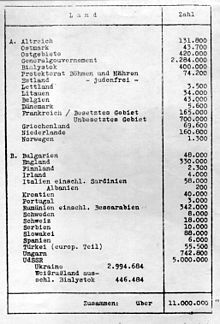Holocaust in Latvia
| The Holocaust in Latvia | |
|---|---|

Exhibit presented at the Wannsee (Holocaust planning) Conference on January 20, 1942, showing only 3,500 Jews left alive in Latvia of about 60,000 in the country at the time of the Nazi takeover.
|
|
| Also known as | Churbns Lettlands |
| Location | Latvia |
| Date | 22 June 1941 to late 1944 |
| Incident type | Imprisonment, mass shootings, concentration camps, ghettos, forced labor, starvation, mass kidnapping, |
| Perpetrators | Rudolf Lange, Friedrich Jeckeln, Franz Walter Stahlecker, Viktors Arājs and others |
| Organizations | Einsatzgruppen, Ordnungspolizei, Wehrmacht, Arajs Kommando, Latvian Auxiliary Police, Kriegsmarine, and others. |
| Victims | About 66,000 Latvian Jews, 19,000 German, Austrian and Czech Jews, unknown numbers of Lithuanian and Hungarian Jews; unknown but substantial number of Gypsies, Communists, and mentally disabled persons; unknown number of non-Jewish Latvians shot or imprisoned in reprisals and so-called "anti-partisan" activities |
| Memorials | At various points in country, including multiple locations in the Riga area |
The Holocaust in Latvia refers to the war crimes of Nazis and Nazi collaborators victimizing Jews during the occupation of Latvia by Nazi Germany.
The German army crossed the Soviet frontier early in the morning on Sunday, 22 June 1941, on a broad front from the Baltic Sea to Hungary. The German army advanced quickly through Lithuania towards Daugavpils and other strategic points in Latvia. The Nazi police state included an organisation called the Security Service (German: Sicherheitsdienst), generally referred to as the SD, and its headquarters in Berlin was known as the National (or Reich) Security Main Office (Reichssicherheitshauptamt), known by its initial RSHA.
In advance of the invasion, the SD had organised four "Special Assignment Units", which have become known in history by their German name of Einsatzgruppen. The name of these units was a euphemism, as their real purpose was to kill large numbers of people whom the Nazis regarded as "undesirable". These included Communists, Gypsies, the mentally ill, and especially, Jews. The Einsatzgruppen followed closely behind the German invasion forces, and established a presence in Latvia within days, and sometimes hours, of the occupation of a given area of the country by the German Wehrmacht.
The SD in Latvia can be distinguished in photographs and descriptions by their uniforms. The full black of the Nazi SS was seldom worn, instead the usual attire was the grey Wehrmacht uniform with black accents. They wore the SD patch on the left sleeve, a yellowish shirt, and the Death's Head (Totenkopf) symbol on their caps. The SD ranks were identical to the SS. The SD did not wear the SS lightning rune symbol on their right collar tabs, but replaced it with either the Totenkopf or the letters "SD".
The SD first established its power in Latvia through Einsatzgruppe A, which was subdivided into units called Einsatzkommandos 1a, 1b, 2 and 3. As the front line moved further east, Einsatzgruppe A moved out of Latvia, remaining in the country only a few weeks, after which its functions were taken over by the "resident" SD, under the authority of the Kommandant der Sicherheitspolizei un SD, generally referred to by the German initials of KdS. The KdS took orders both from RSHA in Berlin and from another official called the Befehlshaber (commander) der Sicherheitspolizei und des SD, or BdS. Both the KdS and the BdS were subordinate to another official called the Ranking (or Higher) SS and Police Commander (Höherer SS-und Polizeiführer), or HPSSF. The lines of authority were overlapping and ambiguous. The eastern part of Latvia, including Daugavpils and the Latgale region, was assigned to Einsatzkommandos 1b (EK 1b) and 3 (EK 3). EK 1b had about 50 to 60 men and was commanded by Erich Ehrlinger.
...
Wikipedia
